“This post contains affiliate links, and I will be compensated if you make a purchase after clicking on my links.”
Last Updated on January 17, 2024
Among all dog breeds, only two display the Harlequin coat color – the Beauceron and the Great Dane. However, the coat color is mostly associated with the Great Dane breed since Beaucerons are pretty rare in the country.
Thus making the Harlequin coat color a rare color for not only the Great Dane breed but for all dog breeds. And due to their perfect monochromatic color, they are very popular compared to other Great Dane coat colors.
In this article, you’ll find out everything you need to know about the rare and unique Harlequin Great Dane.
Appearance
The Harlequin Great Dane is adorned with the perfect color combination of white and black. It has a white base coat, with black patches throughout its body. And due to the coat colors’ very distinguishable pattern, it’s easy to tell them apart from other Great Danes.
Harlequins, especially when they’re young, are mistaken as Dalmatians. This is because when Harlequins are puppies, the black patches on their coat look like spots. But the spots eventually change shape and their coat color is “finalized” once they reach adulthood.
Furthermore, while both breeds share a striking resemblance, the black coat on a Harlequin comes in irregular shapes and look like patches. And the black coat on a Dalmatian look more rounded like spots.
AKC’s Standards for Harlequin Great Danes
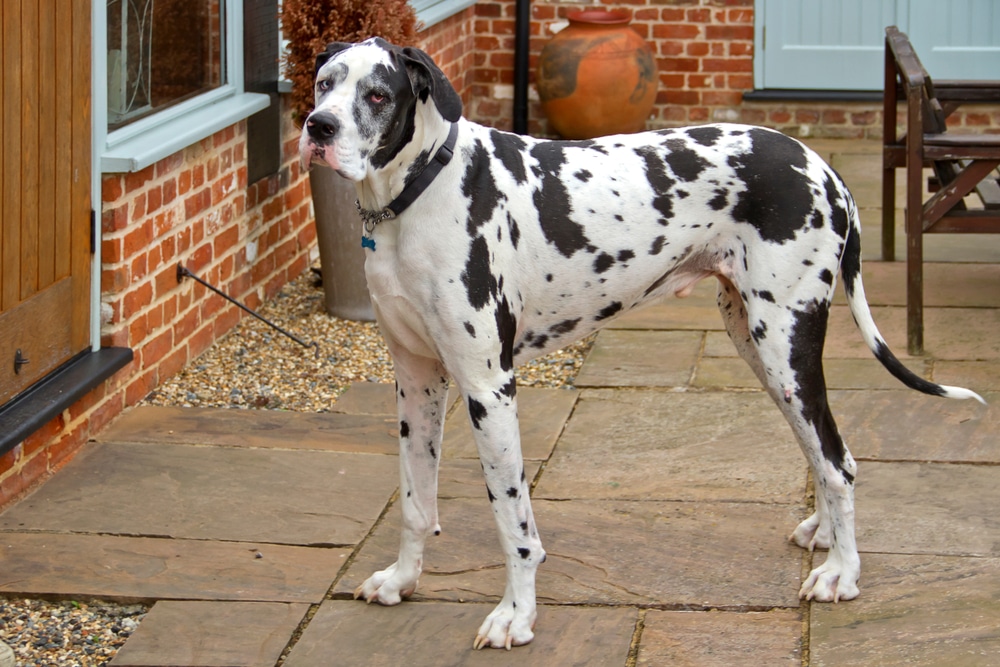
There are strict standards set by the American Kennel Club (AKC) for show Harlequin Great Danes. And these are the following:
- Base color shall be white with black torn patches. Merle patches are normal.
- Black torn patches well distributed over the body; with whole or partial white neck.
- Black pigment may be seen on the skin in white areas.
- No patch should be so large as it appears to be a blanket.
- Eligible but less desirable, are black hairs showing through the white base coat which gives a salt and pepper or dirty appearance.
The first point explains that the base color of the Harlequin should be white with black patches. Merle or grey patches are also permitted by AKC. However, these grey patches are not acceptable for dog shows.
Second point discusses the distribution of the black patches. While no two Harlequin Great Danes have the same exact black patches, they should still be well distributed all over the body. Furthermore, the neck should be fully or partially white.
Third point mentions that black pigment on the skin where the white coat is, is acceptable by AKC’s standards.
Fourth point explains that the black patches shouldn’t be too large. Because if the “patches” look like “blankets”, then it would be a little difficult to distinguish them from Mantle Great Danes.
And the final point indicates that the black hair that show through the white base coat are eligible but less desirable. This is because it gives the coat a “dirty”, salt and pepper, and less distinct appearance.
Mismarked Harlequin Great Danes
Like all the other Great Dane coat colors, when there are standard Harlequins, there are also mismarks.
It is worth noting that the AKC standards are relevant if you intend to make your Harlequin Great Dane a show dog. However, if what you need most is an ideal family companion, then a mismark is as good as a standard Harlequin.
The following are mismarked Harlequin Great Danes:
1. Merlequin Great Dane
Merle Harlequins or Merlequins have striking resemblance to the normal Harlequin Great Danes. Their only difference is the color of the patches. For Merlequin Great Dantes, the patches are a combination of black and grey.
And at times, they have less spots due to having two copies of the merle genes and no copies of the harlequin genes.
2. Brindle Great Dane
Brindle Great Danes might be the rarest Harlequin mismark because it has 3 coat colors. They have a white base coat color and their patches are a combination of the fawn and black coat colors of a Brindle.
3. Blue Harlequin Great Dane
A Blue Harlequin is another interesting mismark. It has the usual Harlequin coat pattern with a white base coat, but the irregular patches around its body are gray. Unlike other mismarks of the Blue Great Dane, the Blue Harlequin doesn’t have the typical “blue” coat color. Furthermore, most if not all, have a distinct gray nose and blue eyes.
4. Fawn Harlequin Great Dane
A Fawn Harlequin’s coat color is a unique mixture of fawn and white. They have a white base coat and fawn patches throughout their bodies.
How much do Harlequin Great Danes Cost?
Harlequin Great Danes cost around $500 to $3000. Show quality Harlequin Great Danes are more expensive compared to pet Harlequins and prices differ according to your location.
Harlequins are generally more expensive than other Great Dane coat color because breeding them can be quite difficult and they’re considered a rare coat.
How rare are Harlequin Great Danes?
Harlequins are considered rare, not only for Great Danes, but for all dog breeds. As a matter of fact, the AKC only recognizes two dog breeds with the Harlequin coat: the Great Dane and the Beauceron.
Although, there are some breeds that are called Harlequins because of their resemblance to the rare coat. However, these breeds are mostly related to the Merle coat color and do not meet the standards of a Harlequin. Some of these breeds are the Miniature Pinscher, Australian Shepherd, Shetland Sheepdog and Border Collie.
Genetics
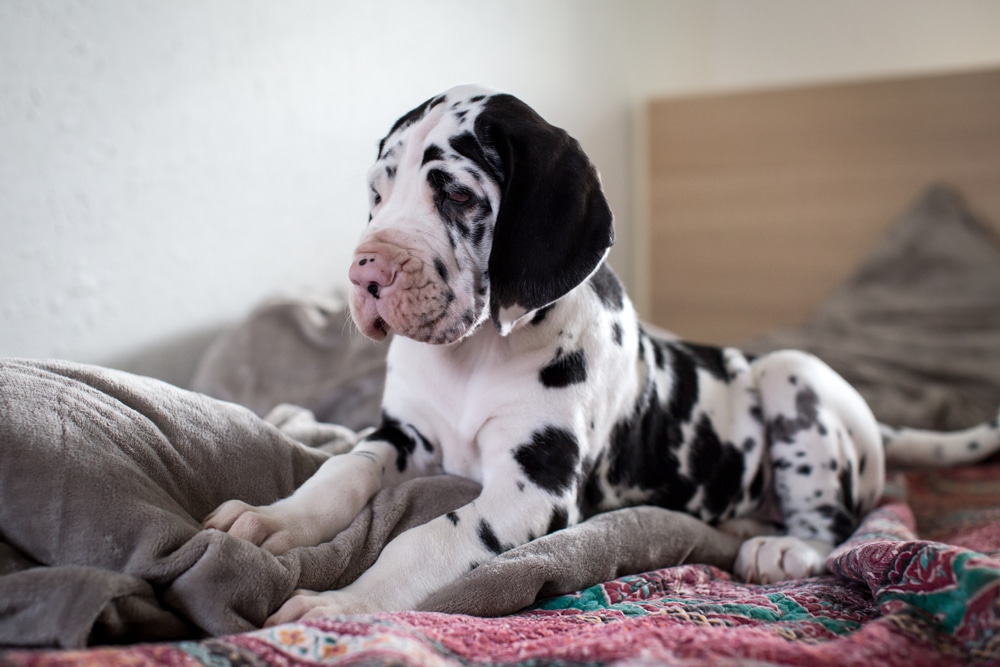
For a Great Dane to exhibit the Harlequin coat color, it must inherit both Merle gene and Harlequin gene from its parents. The Harlequin gene makes the gray or marbled patches on a Merle coat to turn white, which creates the unique pattern.
That also means that when a Great Dane has a Harlequin gene but has no Merle gene, it will turn out to have a standard coat color. The Merle gene goes hand in hand with the Harlequin gene to create the pattern.
According to a research, Harlequin is basically the modification of Merle. And without Merle there would be no Harlequin. This is further proven by Dr. O’Sullivan, who suggests that a Harlequin Great Dane can also be produced from breeding Merle with a Blue. Therefore, showing the relationship between a Harlequin and Merle.
Did you know?
One of the highly celebrated Harlequin Great Dane dog show lines began with a Merle Great Dane. As numerous Great Dane dogs of the lineage were dog shows champions.
Breeding
Breeding a Harlequin Great Dane is difficult. It takes a lot of trial and errors and requires extreme precision. And this is why they’re a very expensive and rare coat color.
To produce Harlequin Great Danes, breeders mate Merles or Harlequins with Mantles. However, no matter how much breeders try to produce Harlequins with the perfect coat pattern, it is always inevitable to get mismarked puppies in a litter.
Furthermore, Great Danes with the Harlequin coat are usually “fragile” when it comes to breeding. This is because when bred with Merles or fellow Harlequins, the puppies in the litter will be prone to certain health problems. Therefore, breeders usually mate Harlequins with Mantles.
Can you breed two Harlequins?
No, you shouldn’t breed two Harlequins. This is because it will result in a Great Dane with either a double Harlequin gene or a double Merle gene. And either results will spell disaster, even if the Harlequins are perfectly marked and healthy.
A dog with a two Harlequin gene is unhealthy and is terminated in utero. And a dog with two Merle gene will be born but the chances of it being deaf or blind are high.
Characteristics and Temperament
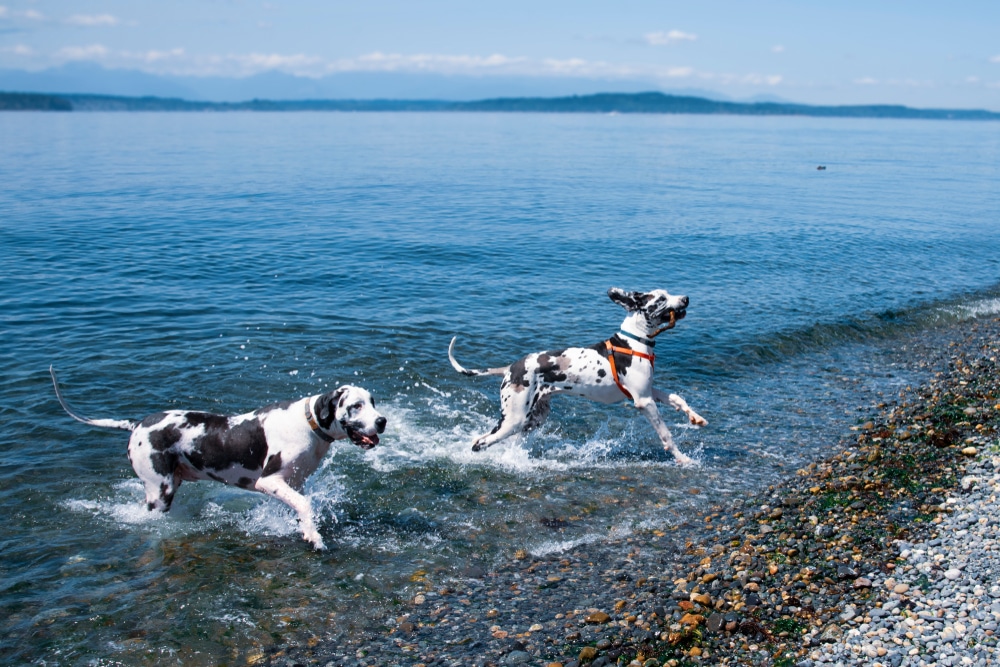
Harlequin Great Danes share common traits with other Great Dane coat colors. They are obedient, social, friendly, loyal and make great guard dogs.
They are revered for their temperament. These gentle giants hold a friendly, warm, amenable, and loving disposition. The dogs are neither too active nor require high level of physical exercises, therefore they can live comfortably and happily in an apartment.
Thus, Harlequin Great Danes are probably the most friendly canines out there. The dogs are good with kids, small dogs, and even cats. And there is a high possibility that they will be a good family dog provided they are trained properly.
Growth
Unlike other Great Danes with different coat colors, the growth of a Harlequin is rather spontaneous. They have the latency to be bigger than other Great Danes and experience a growth spurt later in life.
A Great Dane’s rapid growth usually happens while they’re 3 to 5 months old. However, this varies from dog to dog and from litter to litter. But for a Harlequin, the chances of it going through a growth spurt at 11 months is higher than other coat colors of the same breed.
Sometimes, other than its coat color, genetics also play a part in determining how big a Great Dane gets. So, it is also worth noting that a Harlequin’s size cannot be predicted accurately, because it might take after its parents size.
Health Issues
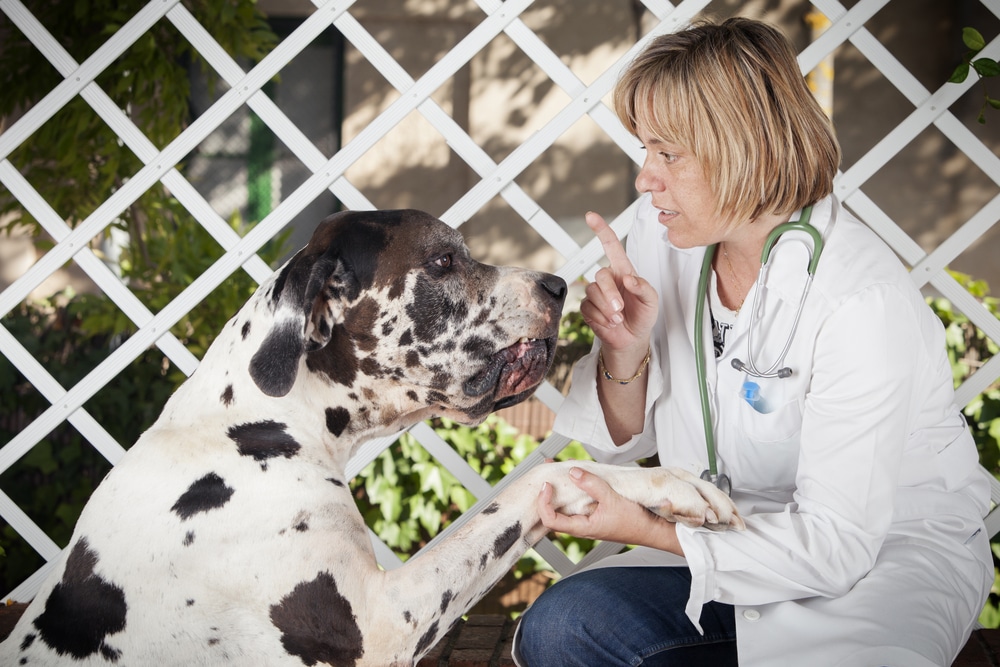
Other than the common health issues that the Great Dane breed is predisposed to, there are also other problems that Harlequins can have due to their coat color.
As mentioned above, breeding Harlequin Great Danes with a Merle or with another Harlequin will cause health complications. And they will either die in utero or be born deaf or blind.
According to a research about canine deafness, 54.6% of double Merles suffer partial hearing loss. Furthermore, lightly marked Harlequins or Merlequins can also get diagnosed with skin cancer due to the lack of pigment.
Shedding
Yes, Harlequin Great Danes do shed. However, the shedding isn’t excessive and is actually seasonal. And they particularly shed a lot during the spring season.
If the dog is healthy, it will shed the same as any other Great Dane color would. And the dogs will only require minimal to average grooming.
Conclusion
Having a Harlequin Great Dane is like having a big bundle of joy in the family. In addition to that, they’re also a beautiful and rare choice for a Great Dane – whether they’re a mismark or not.

But of course, having a Harlequin can be a double-edged sword. While they display a majestic and rare coat color, the chances of them having complications are high. So, it means you have to do a lot of research and equip yourself with patience and effort to ensure that just like any other dogs, they’ll get to live the best life and enjoy all the good things life has to offer.
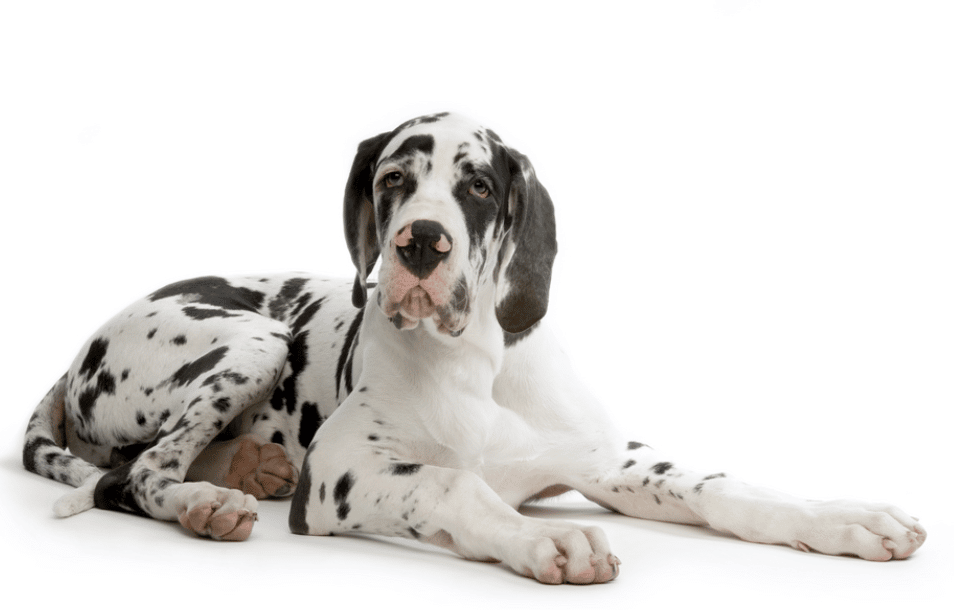
My wife and I are considering getting a harlequin (at last). We’ve actually been on the fence for some years but in recognizing the great responsibility that comes with parenting a great dane, hesitation and procrastination have always prevailed. We are counting our years now, however, and it has come to a now or never decision. Why a harlequin? In my youth, I took care of my neighbors three fawn danes, primarily cleaning his yard, the experience seeding a healthy respect and fondness for the breed. My wife, on the other hand, preferred a dalmatian, primarily stricken by their beautiful markings. Thus a compromise was agreed upon that, should the time come, a harlequin was the answer. I think that time is come, the shopping around exercise to begin as soon as our heat wave subsides. I want to thank you for your very ministering website. I’m sure it has been helpful to many and we will certainly be calling on you soon.